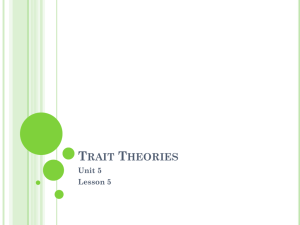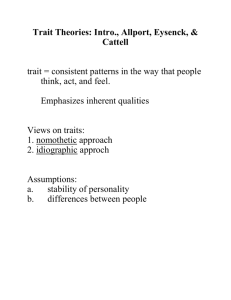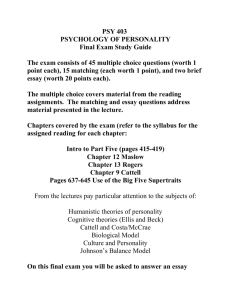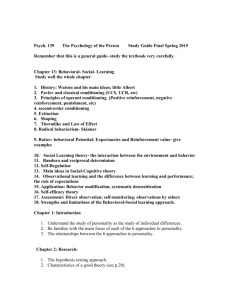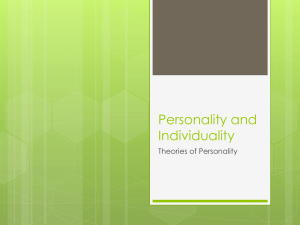Dimensions of Personality
advertisement
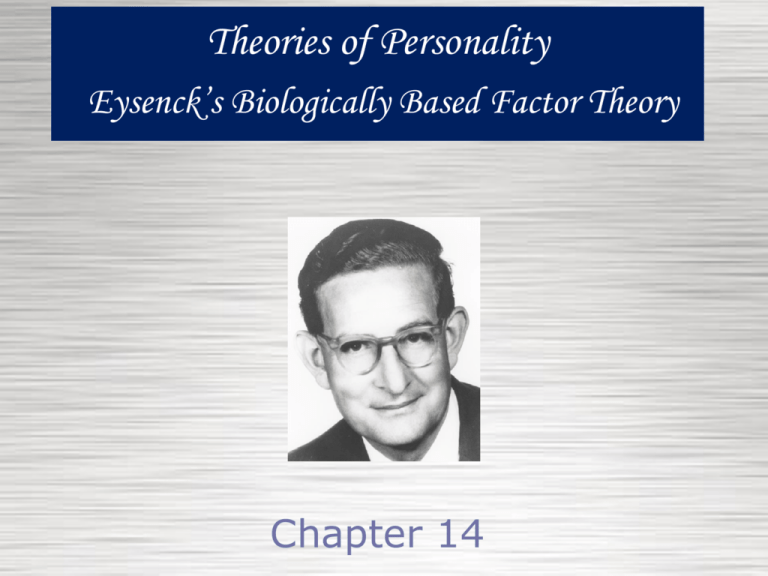
Theories of Personality Eysenck’s Biologically Based Factor Theory Chapter 14 Outline • • • • • • • • • • • Overview of Factor and Trait Theories Biography of Hans J. Eysenck Basics of Factor Analysis Eysenck’s Factor Theory Dimensions of Personality Measuring Personality Biological Bases of Personality Personality as a Predictor Related Research Critique of Trait and Factor Theories Concept of Humanity Overview of Factor and Trait Theories • Utilize Factor Analytic Methods to Determine How Many Traits or Dispositions • Disagreement on How Many Personality Traits – Cattell: Many Factors – Eysenck: Three Factors – McCrae and Costa: Five Factors Biography of Eysenck • Born in Berlin, Germany in 1916 • As a teenager, moved to England to escape Nazis • Received his PhD in psychology at the University of London in 1940 • Published Dimensions of Personality in 1947 • One of the most prolific and controversial psychologists in the world • Died in 1997 at age 81 Basics of Factor Analysis • Correlation coefficient • Factor analysis • Factors • Factor loadings • Unipolar and bipolar traits • Eysenck orthogonal rotation • Cattell oblique rotation Cattell’s Trait Theory • Cattell’s Method – Used inductive method to gather data – Used three different media of observation • L data • Q data • T data – Divided traits into common and unique traits – His approach yielded 35 primary or firstorder traits Eysenck’s Factor Theory • Criteria for Identifying Factors – – – – Psychometric evidence Heritability Must make sense from a theoretical point of view Must possess social relevance • Hierarchy of Behavior Organization (from lowest to highest) – – – – Specific acts or cognitions Habitual acts or cognitions Traits Types or superfactors Dimensions of Personality • Three General Superfactors – Extraversion – Neuroticism – Psychoticism Biological Basis of Personality • Three fourths of personality dimensions can be accounted for by heredity • Found these factors to exist crossculturally • Stability of traits over time • Twin research suggests strong similarities on these dimensions Critique of Trait and Factor Theories • Trait and Factor Theories are: – Very High on Generating Research and Parsimony – High on Organizing Knowledge – Moderate on Falsifiability – Moderate to Low as a Guide for Practitioners and Internal Consistency Concept of Humanity • Eysenck is not concerned with concepts of determinism versus free choice, optimism versus pessimism, and causality versus teleology • Biology over Social Influence • Conscious over Unconscious • Uniqueness over Similarity Theories of Personality McCrae and Costa’s Five Factor Trait Theory Outline • The Big Five: Taxonomy or Theory? • Biographies of Robert R. McCrae and Paul T. Costa, Jr. • In Search of the Big Five • Evolution of the Five-Factor Theory • Related Research • Critique of Trait and Factor Theories • Concept of Humanity Overview of Factor and Trait Theories • Utilize Factor Analytic Methods to Determine How Many Traits or Dispositions • Disagreement on How Many Personality Traits – Cattell: Many Factors – McCrae and Costa: Five Factors The Big Five: Taxonomy or Theory? • Taxonomies are not theories • The Five-Factor Model began as an attempt to identify basic personality traits as revealed by factor analysis • Evolved into a taxonomy • The model then became a theory – It can predict and explain behavior Biographies of Robert R. McCrae and Paul T. Costa, Jr. • Robert McCrae was born in Maryville, Missouri in 1949 • Youngest of three children • Completed PhD in psychology at Boston University, where he was referred to Paul Costa • Began collaborating in 1976 • Costa was born in Franklin, New Hampshire in 1942 • He received his PhD in human development from the University of Chicago in 1970 • The collaboration between McCrae and Costa has been fruitful, producing over 200 joint publications In Search of the Big Five • Five Factors Found – Costa and McCrae utilized every major personality inventory and came up with a five-factor solution – Most personality psychologists have opted for this model • Cross-cultural • Demonstrate stability over time • Description of the Five Factors – – – – – Extraversion Neuroticism Openness Agreeableness Conscientiousness Evolution of the Five-Factor Theory • Units of the Five-Factor Theory – Core Components of Personality • Basic tendencies • Characteristic adaptations • Self-concept – Peripheral Components • Biological bases • Objective biography • External Influences • Basic Postulates – Postulates for Basic Tendencies – Postulates for Characteristic Adaptations Related Research • Personality and Culture – McCrae (2002) – Poortinga et al. (2000) • Traits and Academics – Noftle & Robins (2007) • Traits and Emotion – McNiel & Fleeson (2009) – Robinson & Clore (2007) Critique of Trait and Factor Theories • Trait and Factor Theories are: – Very High on Generating Research and Parsimony – High on Organizing Knowledge – Moderate on Falsifiability – Moderate to Low as a Guide for Practitioners and Internal Consistency Concept of Humanity • McCrae and Costa are not concerned with concepts of determinism versus free choice, optimism versus pessimism, and causality versus teleology • Biology over Social Influence • Conscious over Unconscious • Uniqueness over Similarity

